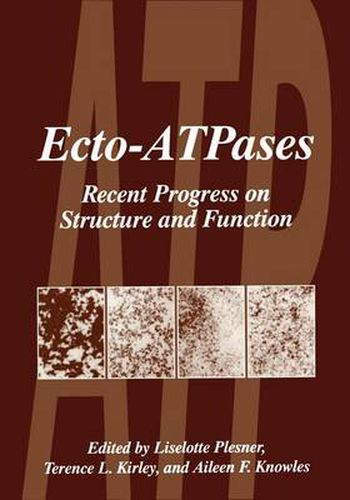Readings Newsletter
Become a Readings Member to make your shopping experience even easier.
Sign in or sign up for free!
You’re not far away from qualifying for FREE standard shipping within Australia
You’ve qualified for FREE standard shipping within Australia
The cart is loading…






This title is printed to order. This book may have been self-published. If so, we cannot guarantee the quality of the content. In the main most books will have gone through the editing process however some may not. We therefore suggest that you be aware of this before ordering this book. If in doubt check either the author or publisher’s details as we are unable to accept any returns unless they are faulty. Please contact us if you have any questions.
It has been known for almost 50 years that many cells carry enzymes that hydro- lyze extracellular ATP, and the term ecto-ATPase was used first by Engelhardt 40 years ago. But until the end of the 1970’s, the idea of an ATPase with its ATP hydrolyzing site on the outside of the cell membrane was met with substantial skepticism since it was thought that ATP was strictly intracellular. Nevertheless, ecto-ATPase activity was dem- onstrated using a variety of intact cells. Most ecto-ATPase(s) exhibited three common 2 characteristics: 1) activation by either Ca + or Mg2+, 2) insensitivity to the commonly used inhibitors ofF-type, P-type, and V-type ATPases, and 3) ability to hydrolyze nucleo- side triphosphates and often nucleoside diphosphates as well. At the same time, the dominant ATPase activity in many plasma membrane preparations was shown to be dis- tinct from the ion-pump ATPases, but had similar enzymatic properties as the ecto-AT- Pase(s). Thus the term E-type ATPase activity has been proposed for ATPase activity exhibiting these characteristics, and it is assumed that all ecto-ATPases are E-type AT- Pases. The converse is not true, however, since soluble E-type ATPases were shown to ex- sist in plants, microorganisms, and the saliva of blood sucking insects. These enzymes could be easily purified, and exhibited very high specific activity.
$9.00 standard shipping within Australia
FREE standard shipping within Australia for orders over $100.00
Express & International shipping calculated at checkout
This title is printed to order. This book may have been self-published. If so, we cannot guarantee the quality of the content. In the main most books will have gone through the editing process however some may not. We therefore suggest that you be aware of this before ordering this book. If in doubt check either the author or publisher’s details as we are unable to accept any returns unless they are faulty. Please contact us if you have any questions.
It has been known for almost 50 years that many cells carry enzymes that hydro- lyze extracellular ATP, and the term ecto-ATPase was used first by Engelhardt 40 years ago. But until the end of the 1970’s, the idea of an ATPase with its ATP hydrolyzing site on the outside of the cell membrane was met with substantial skepticism since it was thought that ATP was strictly intracellular. Nevertheless, ecto-ATPase activity was dem- onstrated using a variety of intact cells. Most ecto-ATPase(s) exhibited three common 2 characteristics: 1) activation by either Ca + or Mg2+, 2) insensitivity to the commonly used inhibitors ofF-type, P-type, and V-type ATPases, and 3) ability to hydrolyze nucleo- side triphosphates and often nucleoside diphosphates as well. At the same time, the dominant ATPase activity in many plasma membrane preparations was shown to be dis- tinct from the ion-pump ATPases, but had similar enzymatic properties as the ecto-AT- Pase(s). Thus the term E-type ATPase activity has been proposed for ATPase activity exhibiting these characteristics, and it is assumed that all ecto-ATPases are E-type AT- Pases. The converse is not true, however, since soluble E-type ATPases were shown to ex- sist in plants, microorganisms, and the saliva of blood sucking insects. These enzymes could be easily purified, and exhibited very high specific activity.